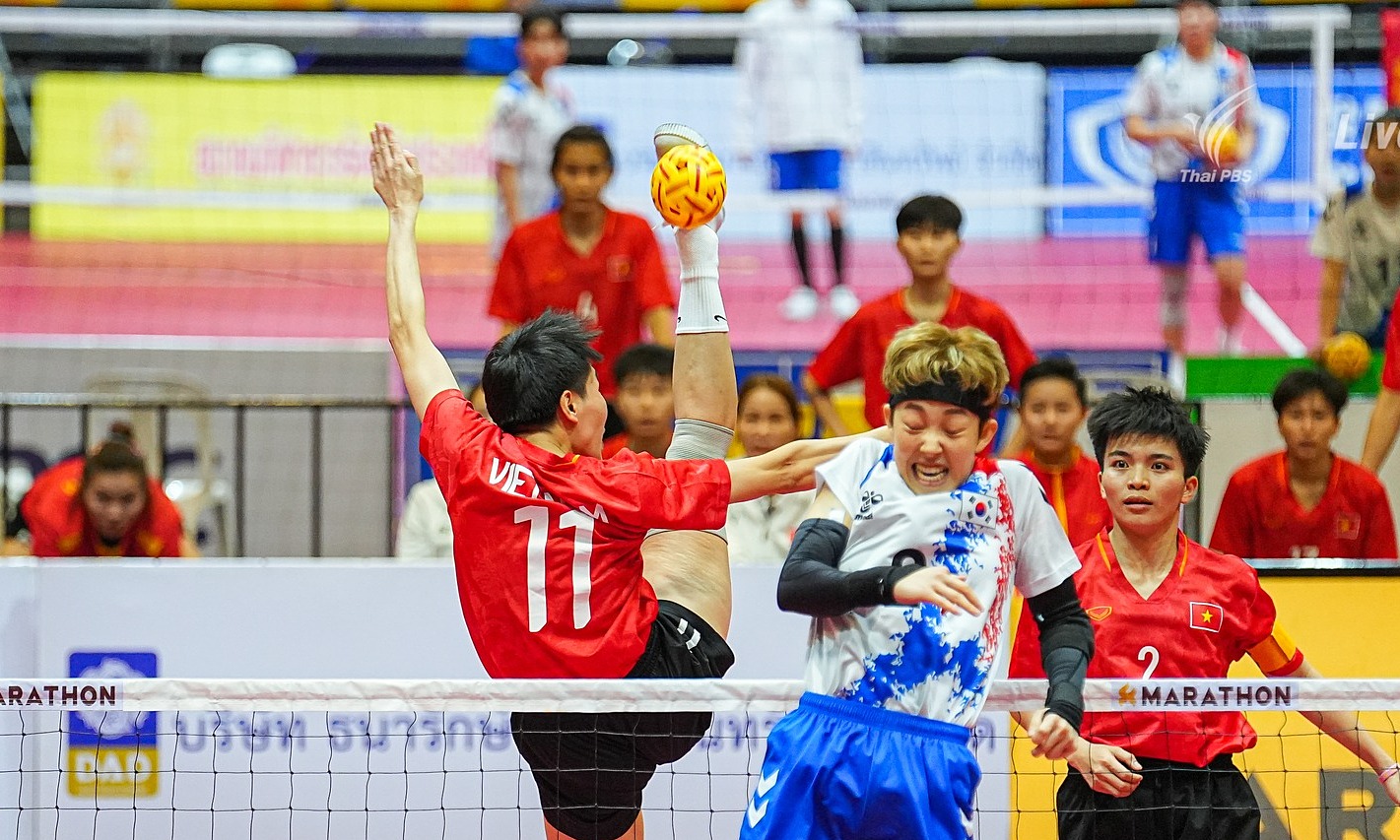In the first set, 7 of Thailand's 15 points followed a similar pattern: Ratsamee Thongsod's spikes hit the Vietnamese block and went out of bounds. Additionally, the home team scored 3 points when the ball hit the block and landed on Vietnam's side. This meant that for 10 of Thailand's points, Vietnam's block made contact but still lost the point.
Only once did Ratsamee's spike hit the block and land on Thailand's side, which they managed to recover and continue their attack. Vietnam successfully blocked and retrieved the ball just once. In one instance, a Vietnamese player touched the net while blocking, resulting in a point for Thailand.
 |
The Vietnamese women's sepak takraw team celebrates their world championship victory in the 4-person event, at Central Hatyai shopping center, Songkhla province, Thailand, 27/7/2025. Photo: Tue Tran |
Recognizing the issue with the blocking, coach Tran Thi Vui made a small but crucial adjustment during the break before the second set. She instructed her players to keep their backs straight while blocking, instead of bending forward. Bending, she explained, would cause the ball to deflect out of bounds even if blocked. A straight back increased the likelihood of the ball landing on the opponent's side.
Coach Vui's adjustment quickly paid off at the start of the second set. Thailand was leading 2-1 and Vietnam was serving. Thailand had an attack opportunity, but Ratsamee's spike hit Nguyen Thi Yen's straight back and landed on Thailand's side, giving Vietnam the point and a 4-2 lead.
In Ratsamee's next attack, the ball again hit Tran Thi Ngoc Yen's back and deflected onto the Thai side, resulting in another point for Vietnam. In the second set, the Vietnamese team successfully blocked two more of Ratsamee's spikes to score points.
Coach Poonsak Permsak immediately substituted Ratsamee with Manlika Bunthod. Taller and more powerful, Manlika delivered stronger spikes, scoring two points by hitting the top of the Vietnamese block and sending the ball out of bounds.
However, in the third set, Manlika's strategy began to falter. With Thailand leading 5-4 and on the attack, her spike hit the Vietnamese block and fell on their side. Vietnam then scored another point off a block, extending their lead to 8-5 and ending a 6-point streak.
 |
Nguyen Thi Yen spikes during the semi-final against South Korea on 25/7/2025. Photo: PBS |
Considering only points scored directly after the ball hit the Vietnamese block, the first set score was 10-0 in Thailand's favor. This statistic shifted to 6-4 in Vietnam's favor in the following two sets.
In 4-person sepak takraw, the server stands behind the back line, putting the serving team at a disadvantage, similar to volleyball. In the 3-person format, the server stands in a circle at the center of their court, closer to the net. This allows serves to be used offensively, much like in tennis.
At the world championship level, each point scored while serving is crucial, somewhat akin to a "break point" in tennis. The straight backs of the Vietnamese players were instrumental in their historic comeback victory against Thailand in the sepak takraw final.
Several other factors contributed to Vietnam's victory on Thai soil. Coach Vui noted that Ratsamee and Manlika were initially more energetic, resulting in more confident and accurate spikes. However, their power and precision waned, allowing Vietnam to score crucial points. Thailand also seemed to lose morale as their deficit grew in the third set, leading to errors and missed opportunities.
When Thailand served, Tran Thi Ngoc Yen became the star for Vietnam. Player number 4 scored the majority of points for her team, consistently delivering in crucial moments. Wiphada Chitphuan also missed approximately 7 serves, including the final one.
Xuan Binh












